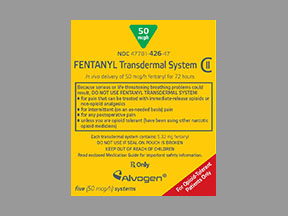
Duragesic-50 Coupons & Savings Card – Discount Prices from $103.92
Brand for: Fentanyl
My prescription
Edit
50MCG/HR, Fentanyl (30 Patch 72 Hours)
Select pharmacy

CVS
$103.92
COUPON PRICE
Walgreens
$192.51
COUPON PRICE
Rite Aid
$297.89
COUPON PRICE
Albertsons
$344.34
COUPON PRICEDuragesic-50 savings card
Show this card to your pharmacist
CVS
$103.92
BIN
ID
PCN
GRP
019876
LHE81F2D43
CHIPPO
LHX
Powered by
More prescriptions for pain
More prescriptions for pain
Price history for Fentanyl (generic)
30, 50MCG/HR
Average retail price for Fentanyl
Average SaveHealth price for Fentanyl
Our price history data is based on aggregated prescription data collected from participating pharmacies in America. Our prescription data updates daily to reflect the latest price changes. If you notice a missing data point, it means there wasn't sufficient data available to generate a monetary value for that date.
Duragesic-50 dosage forms
| Dosage | Quantity | Price from | Per unit |
|---|---|---|---|
| 50MCG/HR | 30 Patch 72 Hours | $103.92 | $3.46 |
Duragesic-50 Warnings
Fentanyl is a potent medication with significant safety considerations. It is essential to understand the associated risks, precautions, and specific instructions for its use to minimize potential hazards. Below are the key safety warnings and guidelines:
Risk of Misuse and Addiction: Fentanyl carries a high potential for abuse and addiction, which can result in overdose and death. Individuals with a personal or family history of substance abuse or mental health conditions are at greater risk. Proper storage, usage, and disposal are crucial to prevent misuse.
Respiratory Depression: This medication can cause life-threatening respiratory depression, even if used as directed. The risk is heightened when starting treatment, changing doses, or using it in combination with other sedatives. Immediate medical attention is required for symptoms such as slow or shallow breathing, extreme drowsiness, confusion, or bluish skin.
Overdose Risk: Always follow the prescribed dosage strictly. Overdosing can lead to severe consequences, including unresponsiveness, extremely slow breathing, and clammy skin. Individuals with a history of opioid use disorder or previous overdoses are particularly vulnerable.
Accidental Exposure: Accidental contact with the fentanyl patch can be dangerous, especially for children, who may experience severe breathing problems or overdose. Ensure patches are kept out of reach and disposed of safely.
Heat Exposure: Exposing the patch to high temperatures can increase drug release, leading to overdose. Avoid heat sources such as heating pads, hot baths, and sunbathing while wearing the patch.
Drowsiness and Cognitive Impairment: Fentanyl can cause extreme drowsiness and impair mental alertness. Avoid alcohol and other sedatives to prevent exacerbating these effects.
Physical Dependence and Withdrawal: Long-term use can lead to dependence, with withdrawal symptoms such as anxiety and sweating occurring if the medication is stopped abruptly. Tapering under medical supervision is advised.
Pregnancy and Newborn Harm: Use during pregnancy can cause the unborn baby to become dependent on the medication, leading to withdrawal symptoms after birth. Pregnant individuals should only use fentanyl if absolutely necessary and under strict medical guidance.
Drug Interactions: Fentanyl may interact with various medications, increasing the risk of adverse effects or reducing efficacy. Inform your healthcare provider of all medications you are taking.
Serotonin Syndrome: Combining fentanyl with drugs that increase serotonin can cause serotonin syndrome, a potentially life-threatening condition. Be vigilant for symptoms such as rapid heart rate and hallucinations.
Low Blood Pressure and Heart Rate: Fentanyl can cause severe drops in blood pressure and slow heart rate, leading to dizziness or fainting, particularly when starting the medication or changing doses.
Adrenal Insufficiency: Long-term use can affect adrenal hormone levels, leading to symptoms like fatigue and nausea. Monitoring and medical intervention may be necessary.
Seizure Risk: Individuals with a history of seizures should exercise caution, as fentanyl may increase the frequency of seizures.
Contraindications: Fentanyl should not be used for short-term, mild, or post-surgical pain, or by individuals who are not opioid-tolerant. It is also contraindicated in cases of severe asthma or respiratory depression.
Always consult your healthcare provider for personalized advice and follow recommended safety measures to mitigate risks associated with fentanyl use.
Duragesic-50 Side Effects
When using this medication, you may experience some common side effects, which are generally mild and manageable. These include nausea, vomiting, sleepiness, dizziness, difficulty sleeping, constipation, increased sweating, tiredness, and a feeling of being cold. Over time, these may lessen as your body adjusts to the medication. For constipation, a diet rich in fiber, adequate water intake, and regular exercise can help, and your pharmacist can recommend a suitable laxative if necessary. To avoid dizziness, rise slowly from a seated or lying position.
Other potential side effects may include headache, diarrhea, stomach pain, dry mouth, a fast heartbeat, feeling unwell, weakness, muscle spasms, numbness, burning or tingling sensations in the limbs, itching, rash, anxiety, and confusion. If any of these persist or worsen, it’s important to consult your healthcare provider.
There are also some serious side effects that, although rare, demand immediate medical attention. These include dangerously slow breathing, symptoms of an overdose like extreme sleepiness and slow heartbeat, and signs of opioid withdrawal such as anxiety and irritability. Additionally, a serious allergic reaction may manifest as a rash, shortness of breath, or swelling of the face and throat.
Furthermore, this medication can rarely increase serotonin and cause serotonin syndrome, especially if combined with other serotonergic drugs. Symptoms of this condition include a fast heartbeat, hallucinations, severe dizziness, and unexplained fever. Immediate medical help is crucial if you experience these severe symptoms. Always inform your doctor or pharmacist about all medications you are taking to minimize risks.
Duragesic-50 Interactions
When using Fentanyl, it's crucial to be aware of potential drug interactions. Some pain medications, specifically mixed opioid agonist-antagonists like Butorphanol, Nalbuphine, and pentazocine, as well as Naltrexone and samidorphan, can interact with fentanyl. Additionally, other drugs may impact how fentanyl is processed in your body, possibly altering its effectiveness. This includes azole antifungals (e.g., Itraconazole, Ketoconazole), calcium channel blockers (e.g., diltiazem, Verapamil), HIV protease inhibitors (e.g., nelfinavir), macrolide antibiotics (e.g., Erythromycin), Mifepristone, Nefazodone, rifamycins (e.g., Rifabutin), Ritonavir, and certain anti-seizure medications (e.g., Carbamazepine, Phenytoin).
Moreover, taking MAO inhibitors with fentanyl can lead to a serious, potentially fatal interaction. You should avoid using MAO inhibitors (such as isocarboxazid, Linezolid, Metaxalone, methylene blue, moclobemide, phenelzine, procarbazine, Rasagiline, safinamide, Selegiline, Tranylcypromine) during fentanyl treatment and generally for two weeks prior. Consult your doctor about when to begin or discontinue these medications.
Using fentanyl with other substances that cause drowsiness or breathing issues can heighten the risk of severe side effects, such as slowed or shallow breathing and extreme drowsiness. These substances include other opioid pain or cough medications (e.g., codeine, hydrocodone), alcohol, marijuana (cannabis), sleep or anxiety medications (e.g., Alprazolam, Lorazepam, Zolpidem), muscle relaxants (e.g., Carisoprodol, Cyclobenzaprine), and antihistamines (e.g., Cetirizine, diphenhydramine). Check all your medications, including over-the-counter ones, as they might have ingredients that induce drowsiness. Consult your pharmacist on how to use these products safely.
The risk of serotonin syndrome, a potentially life-threatening condition, increases if fentanyl is used with other drugs that raise serotonin levels. These include street drugs like MDMA ("ecstasy"), St. John's wort, and certain antidepressants (such as SSRIs like Fluoxetine and paroxetine, and SNRIs like Duloxetine and Venlafaxine). The risk is higher when starting or increasing the dosage of these drugs.
Lastly, fentanyl might interfere with certain lab tests (like amylase or lipase levels), possibly skewing results. Ensure your healthcare providers and lab personnel are aware of your fentanyl use. Always inform your doctor and pharmacist about all medications and supplements you use, including over-the-counter drugs, vitamins, and herbal products, to prevent interactions.
Is DURAGESIC still available?
Yes, DURAGESIC, which is a brand name for the fentanyl transdermal patch, is still available. It is used for managing severe chronic pain in patients who require continuous opioid analgesia.
Is DURAGESIC a pain killer?
Yes, Duragesic is a painkiller. It is a brand name for a transdermal patch that contains fentanyl, which is an opioid analgesic used to manage severe chronic pain.
Is Duragesic discontinued?
Duragesic, a brand name for the fentanyl transdermal patch, has not been discontinued. However, availability may vary based on location and specific formulations. It is important for patients to consult with their healthcare provider or pharmacist for the most current information regarding its availability.
Is Duragesic a schedule 2 drug?
Yes, Duragesic, which contains fentanyl, is classified as a Schedule II controlled substance in the United States. This classification indicates that it has a high potential for abuse, with use potentially leading to severe psychological or physical dependence.
